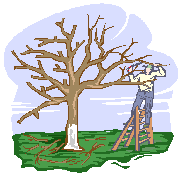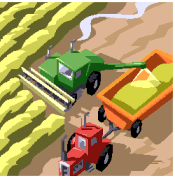

To send a message to an author, click on the author's name at the end of the article.
This Month in Ag Connection | Ag Connection - Other Issues Online
Producers have many opportunities to spend money during the year and feel they need to "skimp" on a few things. However, Breeding Soundness Exams (BSE) are not one of the expenses producers should cut. BSEs start with a 1) physical examination of the bulls, 2) evaluation of the reproduction system and 3) a semen quality appraisal.

As an example, a producer with 100 cows had a calf-crop of about 25% one year and wondered why. Upon further investigation, it was determined that his bulls were not as fertile and sound that year. He decided to not make the trip to the veterinarian to have a BSE performed on his bulls before turning them out to pasture with the cows. He learned a very expensive lesson that year.
The physical examination of the bulls usually starts with observing structural soundness of the bull; eyes, teeth, legs, feet, condition of the bull. If the bull passes this initial inspection, the veterinarian will then look at the scrotum, testicles, penis and conduct a rectal examination to see if the bull has any internal abnormalities. Scrotal circumference should be measured during the examination. For yearling bulls, 30 cm is the absolute minimum while mature bulls should have a scrotal circumference of greater than 34 cm. The third phase of the BSE consists of semen collection via electro-ejaculation and an evaluation of primary characteristics such as semen motility (activity), morphology (percent normal sperm cells) and overall sperm production.
Some things to consider when doing BSE tests:
In summary, now is the time to think about doing your BSE exams and making sure your bulls are in tip top shape before the bulls are put in the pasture for breeding. If the bull needs to gain body condition, have their hooves trimmed or other maintenance done on them, now is the time to do it.
Source: Wendy R. Flatt, MU Extension Livestock Specialist
This Month in Ag Connection | Ag Connection - Other Issues Online
Timely tree pruning is often put off until a natural disaster such as ice or wind storms force the decision. Late winter through early spring is considered the best time of year for pruning trees. Outside of unseasonable warming trends, trees go dormant during the winter months and generally do not start sap flow until early spring. Proactive tree pruning management is necessary for health, beauty and longevity of your tree.
The reasons to take advantage of pruning deciduous trees during this time of year include:

The best long term tree management decision occurs at planting. Choosing the right tree and planting it in the right place allows the tree to grow to its natural size and form where it may need little or no pruning after it becomes established. Yearly pruning during the first few years after planting will often help the tree to become established and to develop a structure that is both strong and aesthetically pleasing for the life of the tree.
For established trees, the best way to plan your pruning attack is to study the natural architecture of your tree from a distance of 50 to 100 feet. First pruning cuts should be directed towards obvious unwanted materials such as dead or dying branches, any cross branches or ones growing towards the tree center and any sprouts or suckers growing at the base of the trunk. After removing the unwanted materials, step back away from the tree for the second round of observations prior to more critical pruning cuts.
Remove branches or cut them back if they have the potential to be hazards in the future. For instance, large limbs growing towards roofs or power lines and lower branches that interfere with traffic or sidewalks. If your tree has more than one central leader (two or more branches competing for the top dominance), cut out all but the strongest so that the tree will regain its normal shape and development. In some cases, single side branches can develop more rapidly than surrounding branches and need to be cut back to slow growth and allow others to catch up. As a general rule, it is never a good practice to prune more than 20% of growth in any given year.

Pruning can involve use of potentially dangerous tools: (pruning loppers, chainsaws, pole saws and ladders) so always remember safety first before starting any project. When cutting large branches, it is best to use the three cut method (See Figure below). Starting approximately 12 inches from the trunk, make the first cut ¼ through on the underside of the branch to be removed. At the same location but on the upper side, the second cut can then be accomplished to remove the weight of the branch. The previous undercut will eliminate bark pealing back to the trunk. The last cut is then made at the branch collar perpendicular to the branch growth. This last cut minimizes the diameter of the cut and allows the most efficient wound for healing. When using loppers on smaller branches, the collar may not be as evident but similar cut principles should be applied to minimize damaging cuts.
It has often been stated that it is easier to practice pruning techniques on a neighbor's tree, but if these pruning strategies are implemented, it will be easier to start closer to home. With any pruning strategies, remember to be safe first as limbs are not easily reattached (plant or human).
More information on Pruning and Care of Shade Trees is available from MU Guide 6866 or information on First Aid for Storm damaged trees MU Guide 6867 is available at your local University of Missouri Extension office or on-line at http://extension.missouri.edu/main/DisplayCategory.aspx?C=2#publications
MU Guide 1959 Basic Chainsaw Safety and Use is also available at http://extension.missouri.edu/publications/DisplayPub.aspx?P=G1959
Source: Todd Lorenz, MU Extension Agronomy and Horticulture Specialist
This Month in Ag Connection | Ag Connection - Other Issues Online

Very good grain prices earlier in 2008, large carryover of grain inventory into 2008, and decent 2008 crop yields are going to result in a high income year for many Missouri farmers. However, we all know farm income is nearly as volatile as our Missouri weather. Congress is aware of the volatility of farm income and has provided for the averaging of farm income. In a nutshell, the farm income averaging provision allows the use of lower unutilized tax brackets of the previous three years in calculating the current year's income tax liability.
For example, if a farmer would be in the 33% tax bracket this year without averaging and the taxpayer did not fully utilize all of the 25% and/or 28% tax brackets during the previous three years - these unutilized amounts can now be used in the calculation of the current year's tax liability. Electing income averaging in this example would reduce the taxpayer's marginal rate by 5 to 8 percent. On several thousand dollars of averaged income - that's a substantial tax savings.
Only farm income is eligible for income averaging. In addition to normal farm production income - gain from the sale of farm business property such as machinery and breeding livestock qualifies as farm income for income averaging. While gain from the sale of real estate does not qualify - gain from the sale of farm business structures attached to the real estate does qualify.
Farm income of a crop-share landlord qualifies for income averaging if the rental agreement is in writing. Not much fuss was made of the written lease requirement in earlier years because very few taxpayers were able to get any advantage from income averaging because of an alternative minimum tax issue that has since been eliminated. If you're a crop-share landlord, you should get your leases established in writing. Putting your leases in writing has always been a recommended business practice - now it is also a requirement for taking advantage of income averaging.
If your farm income was substantially greater in 2008 than the previous three years, you may be able to reduce your income tax liability by income averaging.
Author: Parman Green, MU Extension Agriculture Business Specialist
This Month in Ag Connection | Ag Connection - Other Issues Online
Soil acidity develops gradually in soils mostly due to the natural break down of organic matter, rainfall, crop removal of calcium (Ca) and magnesium (Mg), and the application of nitrogen fertilizers. In acidic soils, proper lime application can be the most effective fertility management in any production system.
Soil pH directly impacts nutrient availability. Increasing the soil pH of an acidic soil also increases fertilizer use efficiency of soil nutrients such as phosphorus (P), potassium (K), nitrogen (N), Ca, Mg, sulfur (S), boron (B), and molybdenum (Mo). Plant toxicities from excess aluminum (Al) and manganese (Mn) availability are reduced with liming.

Liming can lead to a more favorable environment for microbial activity in the soil, improved soil structure and tilth, increased longevity of legumes, and improved activity of certain herbicides. Optimal soil pH allows the breakdown of some herbicides, preventing damage to rotational crops. Finally, the overall benefit from liming your soils comes from increasing the soil pH to the crops most favorable range for growth.
The ideal soil pH for most crops in Missouri is typically a salt pH of 6.0 to 6.5 (the equivalent of a water pH of 6.5 to 7.0). Maintaining the ideal soil pH can lead to improved crop yield. Research has shown increasing a salt pH from 4.5 to 6.0 can increase soybean yields by 15 percent. If soybean yields were 40 bushels per acre, this would mean an increase of 6 bushels per acre. However, it is important to remember that the optimum pH is not the same for all crops or soils.
Before you apply lime to your soils, a soil test should be done in order to obtain a lime recommendation. A lime recommendation will take into account the differences in acidity among soils as well as differences among various crops' tolerance to acidity. The lime recommendation is expressed in effective neutralizing material (ENM), which is a term used to express an amount of agriculture limestone to apply to soil to get the proper change in soil pH. If your soil test analysis recommends an application of limestone, it will call for a given amount of ENM to be applied.
For more information on liming see MU Extension guide sheets:
G9102, Liming Missouri Soils - http://extension.missouri.edu/publications/DisplayPub.aspx?P=G9102
G 9107, Missouri Limestone Quality: What is ENM? - http://extension.missouri.edu/publications/DisplayPub.aspx?P=G9107
Source: Joni Ross, MU Extension Agronomy Specialist
This Month in Ag Connection | Ag Connection - Other Issues Online

Beef cattle producers interested in participating in the Show-Me-Select (SMS) Heifer Development Program need to have their membership dues paid during February, 2009. Dues are $5, payable to Show-Me-Select, Inc. Members will receive updated program requirements and the associated forms to be used for recording heifer data that is entered into the statewide database.
For more information on the SMS program, contact your local Livestock Specialists Gene Schmitz in Benton County, Wendy Flatt in Howard County, or Mark Stewart or Dee Cooper in Callaway County.
Dues should be mailed to:
Gene Schmitz, CM Regional SMS Coordinator,
Benton County Extension Center
P.O. Box 637
Warsaw, MO 65355
Source: Gene Schmitz, MU Extension Livestock Specialist
This Month in Ag Connection | Ag Connection - Other Issues Online
Publishing Information
Ag Connection is published monthly for Northeast and Central areas of Missouri producers and is supported by the University of Missouri Extension, the Missouri Agricultural Experiment Station, and the MU College of Agriculture, Food and Natural Resources. Managing Editor: Mary Sobba.